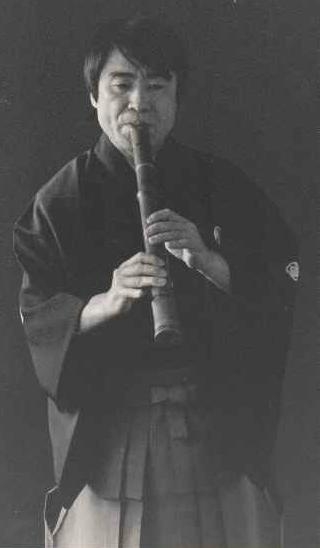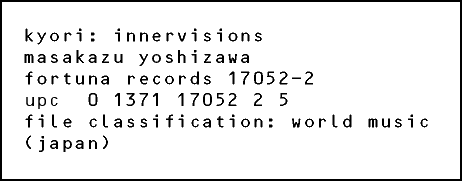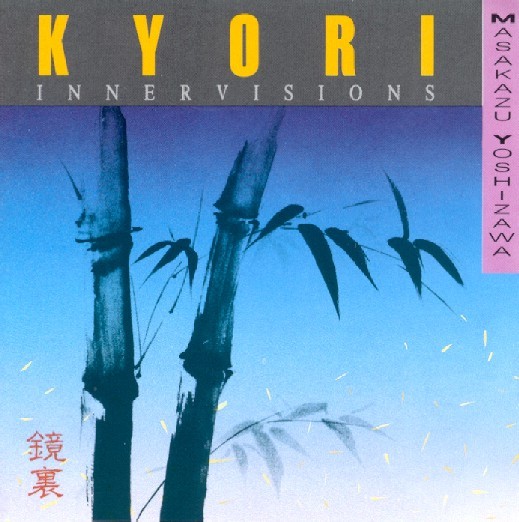Der in Japan geborene Komponist kehrte nach seiner Ausbildung in
westlicher Klassik über die Bambusflöte Shakuhachi zurück
zu den Quellen seiner heimatlichen Kultur. Traditionelle, dynamisch-virtuose
Solostücke und eigene Kompositionen für Shakuhachi (Yoshizava),
Koto, Biwa, Gitarre (Osamu Kitajima) und Schlaginstrumente (Geoffrey
Hales). Zengeist in unserer Zeit. Der nächste Moment ist nicht
voraushörbar.
the project
In
Kyori, Japan's ancient musical traditions are shaded with
western tones and influences. The result is a resonant, rhythmical and
mysterious confluence of cultures.
The man whose innervisions come to life on this recording
is Masakazu Yoshizawa. His desire was to blend the best of his own
Japanese cultural roots with the best of the Eastern-style musical
conventions in which he was educated. He succeeds beautifully, combining
traditional themes and instruments in an arrestingly modern style.
Yoshizawa who is a composer as well as a performer, plays the shakuhachi
(bamboo flute). Two of the pieces are his intriguing solo compositions,
one titled Conceptualism (Johakyu) and the other Mainstreams
to Oneness (Kawai). Two other titles are fascinating ensemble
pieces, Immortality (Fuma) and Divine Silhouettes
(Yogo). For these, Yoshizawa brought in Osamu Kitajima to play
acoustic guitar, koto and biwa, and Geoffrey Hales
to play percussion. Once again, Yoshizawa aims to blend Japanese sensibility
with Western idioms.
With Kyori, Masakazu Yoshizawa creates fresh and innovative
music using traditional Japanese instruments. The result is a dramatic
atmosphere of movement and mystery, shadow and light.
the artist

Masakazu Yoshizawa (September 10, 1950 – October 24, 2007) was
a Japanese American flutist and musician, known for his mastery of
the bamboo flute, specifically the shakuhachi. He also mastered
several other traditional Japanese flutes, in addition to other Japanese
and Western musical instruments. He was onsidered a scholar of ancient
and modern Japanese traditional music. His work and music were featured
in a number of major Hollywood studio films and soundtracks, including
The Joy Luck Club and Memoirs of a Geisha.
Yoshizawa moved from Japan to Los Angeles in the mid-1970s. He initially
worked as a musician, often as a clarinet and saxophone player. However,
when he was specifically requested to play the shakuhachi for
a certain job, it sparked his interest in the instrument, as well
as in Japanese music.Yoshizawa returned to Japan to take shakuhachi
lessons before moving back to California.He began to be hired as a
shakuhachi player for film and television, which quickly converted
his passion for Japanese music into a full fledged career.Yoshizawa
explained the interest that film and television producers had in his
music in a 2005 interview with the Cultural News, a web site that
focuses on Japan-themed films: "they wanted a sound that Western
music didn't have . . . that was new and fit the film."
Yoshizawa ultimately played the shakuhachi on dozens of different
movies and television shows.His early movie credits included the Karate
Kid sequels and the 1993 film, Dragon: The Bruce Lee Story.
Yoshizawa began his collaboration with acclaimed film composer,
John Williams, on Steven Spielberg's 1993 blockbuster, Jurassic
Park. He once told the Cultural News web site that Williams asked
him to play the shakuhachi for Jurassic Park
because the instrument "sounds like a dinosaur's cry."
Masakazu Yoshizawa died at his home in San Gabriel, California, of
stomach cancer on October 24, 2007. John Williams released a statement
to the Los Angeles Times following Yoshizawa's death: "Masa
was a brilliant musician and a very important member of the orchestra,
and he will be greatly missed."
tracklist
| |
Conceptualism (Johaku) |
|
| 1 |
Jo/To Begin |
2'26" |
| 2 |
Ha/To Destroy |
1'44" |
| 3 |
Kyu/To Hurry |
1'55" |
| 4 |
Immortality (Fuma) |
13'03" |
| 5 |
Mainstreams to Oneness (Kawai) |
7'51" |
| 6 |
Divine Silhouettes (Yogo) |
11'27" |
| |
Total Time: |
38'37" |







